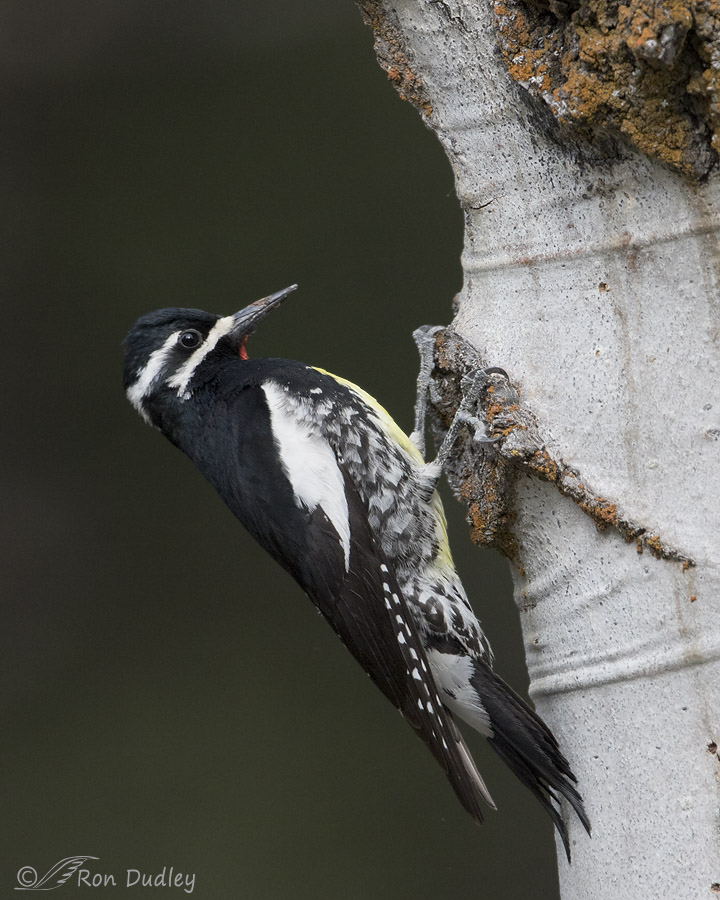This may be the same male Williamson’s Sapsucker that I photographed at the nest tree last July (this image was taken 4 days ago in Clark County, Idaho).
Note: As always I was very careful not to disturb this and other birds at the nest tree. I always shot from my pickup, the tree is within a campsite so the birds are acclimated to vehicles and human activity and I watched for any behaviors that might indicate disturbance.
 1/800, f/7.1, ISO 800, Canon 7D Mark II, Canon EF500mm f/4L IS II USM +1.4 tc, not baited, set up or called in
1/800, f/7.1, ISO 800, Canon 7D Mark II, Canon EF500mm f/4L IS II USM +1.4 tc, not baited, set up or called in
Williamson’s Sapsuckers are monogamous and although they remain together during the breeding season they part after the young fledge. But the same two birds sometimes re-mate in following years and come back to or near their original territory. I never did see a female with this male (sexes are easy to distinguish due to sexual dimorphism) but males arrive on breeding grounds first, several weeks before the female. It’s somewhat unusual for a pair to reuse a nest cavity from the previous year, however they commonly return to the same nest tree and excavate new cavities.
If I remember correctly this is not the aspen that contained the nest holes/cavities but it’s right next to the tree that did. At least one of the nest cavities was being contested by flickers, bluebirds, swallows and nuthatches and by the time we left the much larger Northern Flicker had apparently successfully claimed the largest of the cavities (which it continued to enlarge) and I didn’t see the sapsucker come close to the tree again.
So when it comes right down to it I don’t know for sure if this is last year’s bird or not but I like to think it is. After all, old friends aren’t easy to come by…
Ron
Note – We arrived home from our camping/photo excursion to Montana and Idaho yesterday afternoon. Due to weather/light issues and lack of birds the trip started out slowly but it soon picked up considerably and in validation of that point I now have 4033 images to cull. I’ll post more images from the trip as time allows and as the nasty job of culling progresses.
Despite the fact that I was mostly unable to respond to comments made on posts published while I was gone, many of you commented anyway. Thank you!


EC and Patty, Digital revolutionized photography, that’s for sure. I used to have my own darkroom for film photography and the game was much different then. Gordon Parks was a master so it’s interesting to hear his take on this. For birds in flight I typically take dozens of shots before I get one I keep – completely impractical (at least on my budget) in the film world.
Many, many years ago, I was complaining to a family friend named Gordon Parks, who at the time worked for a magazine called “LIFE”. I was moaning and groaning about what a waste it was and how expensive it was to take a whole roll, or even two, then have to wait days, to find out if I’f even got what I wanted..and then, throw out most if them! “You don’t have that problem” I told him, “Because your pictures are always perfect”. Gordon just about fell down laughing. “Baby! You have NO IDEA how many rolls I shoot to get ONE good image…ONE keeper! HUNDREDS!!!” I waited YEARS for a camera that is smarter then I am, has better vision, can take black or white without changing “film” or carrying another camera; one where you could change speeds , where you could edit and immediately zap rejects, etc., etc., etc. Then the “Foto Fairy” brought us the digital camer…and I fell in love. I zap far more images than I keep…and enjoy zapping rejects almost as much as I like eating chocolate!!!
I like the way it shows how they use their tails for support and balance….
Love your old friend. And your portrait of him.
As you go through all those images aren’t you grateful that you are no longer dependent on film? I suspect many images were not taken because the amateur photographer simply couldn’t afford the processing, knowing they had to live with the duds.
4033 images? Your finger must be worn out. Can’t wait to see the results. I heard a woodpecker or flicker calling this morning. Nice to see this image.
That may seem like a lot of images, Arwen, but when you’re photographing a lot of smaller birds in flight you’re lucky to have about 1 in 50 that’s worth keeping.
Fantastic photograph, Ron! Down here in Florida the only sapsucker we see is the Yellow-bellied and only during migration. I’ve found a few spots where they overwinter and it’s always fun to spot one!
Now, quit reading these comments and get back to culling!
Glad you had a good trip, welcome home!
Only about 3000 to go, Wally. I’m tired of it already…
Beautiful…here’s hoping….
Thanks, Patty.
This is a beautiful shot, and I hope it is your old friend. They always make for a nice encounter.
I hope so too, Susan – partly just because it means that he’s survived for another year.
Magnificent!
Charlotte
Thanks, Charlotte.
Good work with the exposure – nice detail in whites and blacks. I’ve never seen a Williamson’s Sapsucker. Your post stimulated a visit to Sibley and I discovered there are three sapsuckers in the western U.S. that I haven’t seen: Williamson’s, Red-breasted and Red-naped.
Thanks, Dave. I’ve photographed both Williamson’s and Red-naped in this area but the range of the Red-breasted is further west. Perhaps you can get at least two of the three while you’re out west this summer.